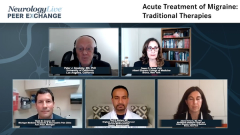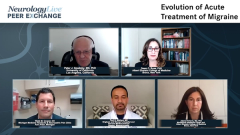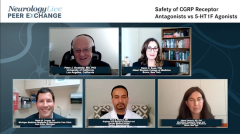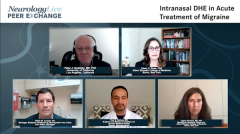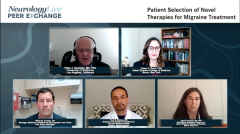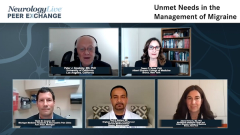
Acute Treatment of Migraine: Traditional Therapies
Episodes in this series

Approaching the acute treatment of migraine, including the use of triptans in therapy.
Peter J. Goadsby, MD, PhD: Let’s talk about some of the treatments. I wanted Wade to talk us through what we’re currently thinking about, in terms of the acute therapies. What are the questions around how satisfied patients are at the moment? What sort of responses do they get? What are the broad, traditional acute therapies that we have to work with at the moment?
Wade M. Cooper, DO: Thanks, Peter. We know that our patients really want effective medicine, medications that have minimal adverse effects, medications that are reliable, and treatments that they know if they take, they can turn off an episode of migraine. That’s been quite a struggle. We know before the 1990s that there was no designed medicine for acute headache. We had stuff that we knew helped turn off headache by helping other things in the body, like NSAID [nonsteroidal anti-inflammatory drug] class medicines and opioids.
It wasn’t until the 1990s when they designed specific medication that targeted what we thought were keys to treating acute migraine. I’m referring to the triptan class medicines. From the mid-1990s through the early 2000s, we had the advent of 7 FDA-approved triptan class medicines for migraine in the United States. Those performed quite well. When we went from nothing to medications that are designed specifically for migraine, that was exciting.
Our patients got to have relief relatively quickly, and sometimes completely. If you look at those medications, they were performing quite well. We think that acute triptan medications—all 7 of them—were somewhere between 50% and 70% effective at reducing pain, or taking pain from moderate to severe to mild, which we call pain relief. But we thought that wasn’t good enough. We started focusing on pain freedom and moving the goalpost a bit. Instead of going from moderate to severe down to mild, we’re talking going from moderate to severe down to nothing.
The triptans really hunkered around 20% for those. Then we started looking at 24-hour pain freedom, meaning how well did it last over 24 hours, as well as complete pain freedom for 24 hours, or “sustained pain freedom” as they would call it. Our medications held that line. Thirty percent or so of triptans maintained that pain freedom for 24 hours. Pain relief was a bit less because it would not always last for a full 24 hours. We’ve built from there with some of the newer, acute therapies.
Peter J. Goadsby, MD, PhD: It always struck me as odd at some level that we would give a person 1 clever treatment and there would still be pain left. As an outsider, I don’t get headache. I know the historical development a bit. As 1 of my older colleagues might say, they advised early triptan manufacturers that if they used pain-free as a goal, people would be disappointed with the outcomes. That’s how the headache response metric got started. I wish it were more intellectual. It wasn’t magic at all. Patients want to be pain-free. Paul, what do you think?
Paul G. Mathew, MD: You’re absolutely right. A big component of all this is patient communication, and that starts in the office. One of the first things that I always do is I ask if the lights are bothering them, and if they say no, I turn them down anyway. You can see a twinkle in their eye, and there’s a look of appreciation because the lights were, in fact, bothering them.
When we take histories, a lot of the time we do need to give ample time for patients to communicate and express themselves, ask open-ended questions, and do the things we’ve all been taught in medical school. Also, it’s important to ask questions even though we know the answers to them, such as, “Is your headache throbbing?” We need to ask about disability and all these details because patients realize, “This doctor gets it. They understand what’s going on.” I find that’s very important in terms of developing the therapeutic alliance.
I can’t stress enough the importance of keeping diaries as well. Keeping diaries is important, not just for the patient to realize just how severe their headaches are and how disabling they are, but also for us to be able to adjust our treatments. It does give a level of satisfaction when you spend some time to review these diaries and really take notes. I transcribe that data into my notes, and the patient says, “Wow, this doctor is really taking the effort that I put in seriously.”
In this newer age in which all these new treatments are coming out, I find 1 amazing question. I might be getting a bit ahead of the game here, which will lead us into some discussions we’re going to have later. I ask, “How satisfied are you with your abortive therapy? Are you having any adverse effects at all?” In the past, that would be looking for trouble, because you’d have an effective treatment, and you wouldn’t have anything else to offer them. You’d say, “Great, I’m glad that worked for you. Sorry, there’s not much better we can do.”
I find myself asking those questions more and more. When you probe, it’s amazing how many people have trouble tolerating their current abortive but bear through it and don’t even mention it to you, because that’s all there is. Likewise, with efficacy, they’ll say the medication works great. When you really probe, they say, “I have to take a second dose 80% of the time,” which clearly is unacceptable, and we’re going to get into that a bit more.
Peter J. Goadsby, MD, PhD: Totally. We have to ask questions we don’t want to hear the answer to. Wade, you mentioned the triptans. They are serotonin 5-HT1B/5-HT1D receptor agonists with very specific pharmacology, which is 1 of the more interesting things, and no general pain effects. Some of them have more 5-HT1F action. What about adverse effects? Paul just brought that up. That’s terribly important. Can you outline for us the general effects, contraindications, and adverse-effect problems that are really bothersome with the triptans?
Paul G. Mathew, MD: Sure, Peter. I’m glad you asked that because it’s a bit sneaky how the triptan adverse effects are listed. They list these in small subgroups. They have chest tightness separate from jaw pressure and whatever else. If you ignore what’s published out there on their package inserts and talk to patients, you’ll find—
Peter J. Goadsby, MD, PhD: We’re not recommending to our colleagues to ignore package inserts. That’s just for clarification, because we support reading FDA package inserts. Sorry to interrupt.
Paul G. Mathew, MD: Thanks, Peter, for your regulatory influence there. Our patients will tell us they like the fact that the triptan medicines work many times for them. However, a lot of the time, they say it makes them feel icky, like they have a pressure in their chest or squeezing of their neck muscles. I hear patients describe scalp tingling and paresthesia. What’s curious about this is that many times, this will delay treatment, or this will make someone not want to use the medicine.
They’ll walk into your office and say, “This works. When I take it, it seems to help my headache.” But what you’ll find, to Paul’s point, is that their calendars don’t go along with this. They’ll have a headache attack, they won’t treat it, and when you ask them why, they’ll say, “I just don’t want to feel gross after my medication. I don’t want to feel medicated. I don’t want to feel prickly, so I have to decide whether I want to use the medicine.” Many times, they wait because of that.
Peter J. Goadsby, MD, PhD: There’s a last part I wanted to cover, because we need to move to the next segment. I wanted Dawn to wrap up by discussing the cardiovascular and cerebrovascular problems with triptans. How common are cardiovascular and cerebrovascular disease in our migraine population?
Dawn C. Buse, PhD: The epidemiology shows that the migraine population tends to be female, at least 3:1. It tends to be active in midlife, rather than at an older age, so we’re starting with a population that does not have as high a risk for cardiovascular events. We need to think about if someone is taking certain exogenous hormones such as birth control or HRT [hormone replacement therapy] if they’re a smoker, and think about the BMI [body mass index]. There may be individual risks within a patient that we want to assess, as well as assessing personal history and family history. It’s something to think about, but it tends to be a population in which we have primarily younger and middle-aged females. We want to remain vigilant, but it may not be as heightened a concern as if we had more men or an older population.
Peter J. Goadsby, MD, PhD: Balanced vigilance. Exactly.
Newsletter
Keep your finger on the pulse of neurology—subscribe to NeurologyLive for expert interviews, new data, and breakthrough treatment updates.

